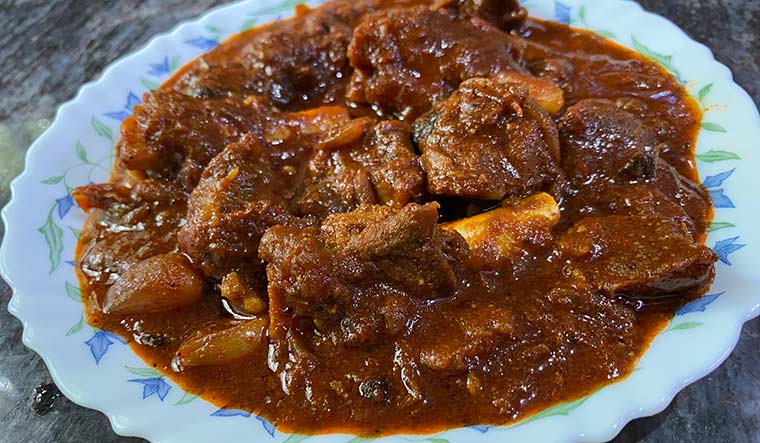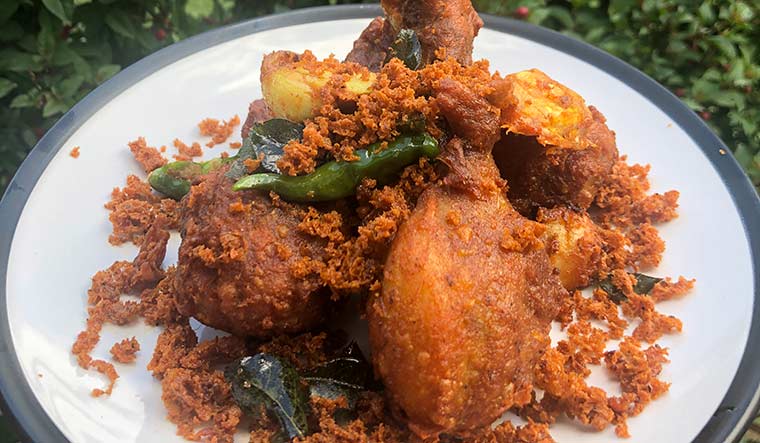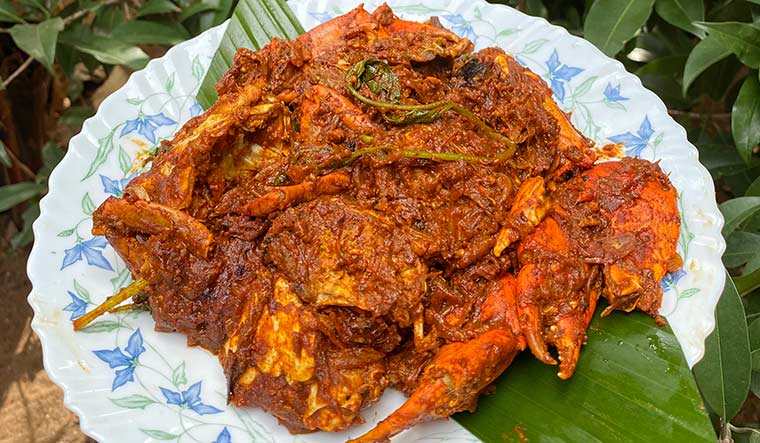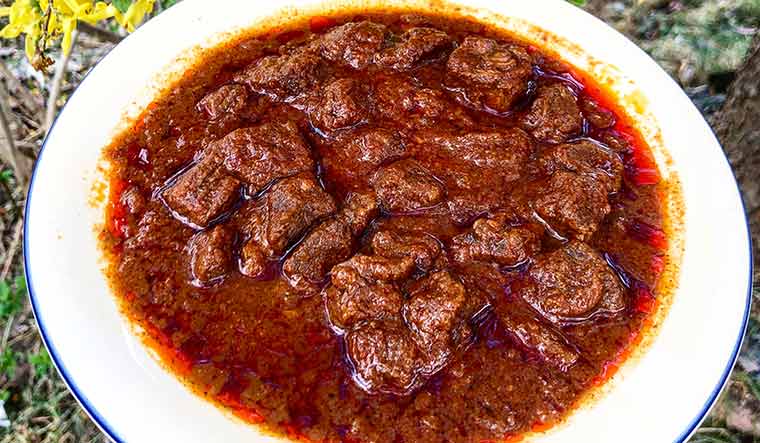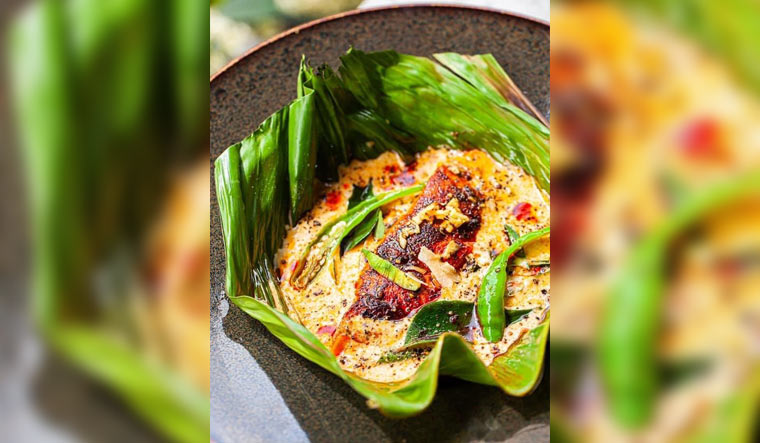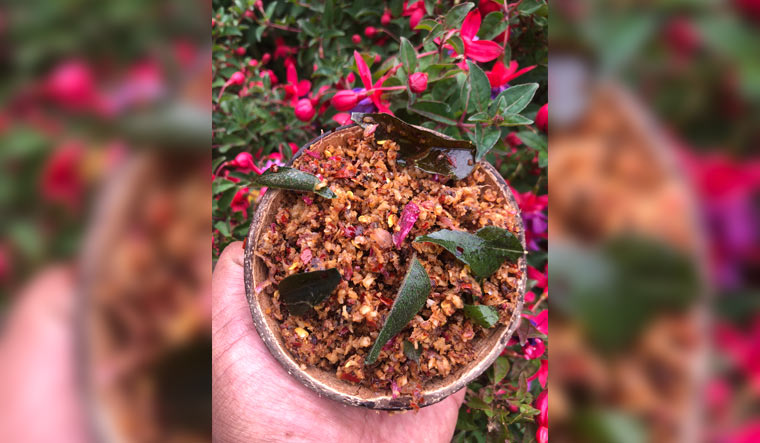When chef Suresh Pillai got selected on the MasterChef stage, all he wanted to do was to make Kerala’s traditional fish curry for the judges. “It was a dream come true for me to participate in MasterChef and also to be the second Malayalee chef to get selected there,” says Suresh. “I used to watch BBC MasterChef; it is the best cookery show. I always had dreams of going there to present a dish from my state.” And he sure made his people proud as globally-renowned judges were in awe at the burst of flavours in Suresh’s plates.
Interestingly, being a chef was never on the cards for him. Although he recalls being interested in helping out his mother in the kitchen, he never thought of cooking as a profession. “My mother used to prepare a lot of seafood as fish is abundant in the place where I live. An island, surrounded by the Ashtamudi lake. Apart from that, Kerala’s biggest harbour is just a few minutes away from my house. So, I learnt different preparations of seafood from my home kitchen—everything from cleaning to marinating and cooking it,” he recalls. Suresh used to also help his neighbour with her street food joint at night. “It was for the fishermen there. We used to serve them tea, steamed rice cake, different curries and other snacks,” he says. “When I think about it now, I actually had a lot of experience with food from a very young age. Even in the school NCC camps, I was always assigned canteen duty where I used to peel eggs and help with washing and chopping vegetables. This was all training for me.”
But it was not an easy walk for him. After completing his Class X, he was prompted to take up a part-time job due to tough financial situations at home. “Initially, I went to this ice parlour near my place for a job but, interestingly, the restaurant next to it hired me. I was barely 16-years-old at the time. They had a small interview and appointed me as a waiter there for a monthly salary of 0460,” he says. Although his job did not include kitchen duties, he developed an interest in understanding how the kitchen works. He used to help the chef by chopping onions, meat and other items in between his waitressing job. “The chef identified my skill and he urged me to pursue it. At the time, I was in no state to go for a formal culinary training. But, I was always a close observer and I learnt most things through that,” says the ever-smiling chef. After over a year of observing and working at the restaurant, Suresh decided to take cooking more seriously. “I travelled to the north of Kerala and learnt how to make Malabari food. From there, I went to Coimbatore, in Tamil Nadu, and worked there for a bit. And then I moved to Bengaluru where my career got its big break. For about six years I worked in a restaurant there called Coconut Grove before I was appointed in The Leela Palace,” Suresh says. His stint at Leela changed his whole style of working and operating as a chef. “It was a whole new experience for me,” he says.
It was not long before he got his international break. “Soon after I got married, I had to return to Kerala for a while but then I got an offer from one of the oldest Indian restaurants in London—Veeraswamy. I worked for about six years there. I also got my British citizenship during this time. And this was when the whole idea of applying for MasterChef also came into the picture,” says the man who impressed culinary experts like Marcus Wareing and Monica Galetti with his flavoursome dishes.
And getting into MasterChef is not a cakewalk. “It was difficult to get in as there are over 1,000 applicants and they choose only 46 participants based on different criteria. Once you apply for the programme, they do a reference check, a telephonic interview followed by an audition where they check your screen presence and confidence. I was lucky to be among the 46 participants selected,” Suresh says. “For my signature round, I made fish curry with mackeral and green mangoes, cake of mashed potato and curry leaves (something similar to the masala dosa stuffing), kate fish with sea salt and pepper crush, and also a pachadi with seaweed and hung yogurt with coriander and olive oil garnish.” Suresh’s plate looked nothing less than a dream with two shades of yellow (the curry and the potato cake), the fish on top and the garnish. Although the chefs loved the flavours, they suggested that the fish was slightly over-cooked. “London taught me a lot of things. For us Indians, taste matters more than visual appeal. We give a lot of importance to taste and quantity more than presentation. I learnt how to create beautiful plates—everything from the intricate cuts to detailed garnishing. The right way to butcher, fillet, debone and cut fish into uniform sizes, it was all revelatory for me,” Suresh says.
After his MasterChef milestone, his culinary journey has been interesting, to say the least. It not only got him media attention and fame but also new opportunities. The Bahamas University invited him as a guest faculty to teach the students in its culinary academy. He also got to be a part of a big charity event over there to raise funds for students who wanted to study culinary programmes in Italy. “I was more than honoured. I never got the opportunity to get formal training but I fully advocate the need for proper culinary coaching,” he says.
Suresh is big on campaigns as well. He did his bit during the #CookforSyria campaign that was launched across Europe to raise funds to help children affected by civil war in the West Asian country. He was working with Hoppers in London at the time. Little did he know that he was a part of a campaign that went on to become a huge global gastronomic crusade. Replicating the same concept, Suresh brought together chefs, homemakers and several food enthusiasts for the cause of helping flood-affected people in Kerala with #CookforKerala campaign during the 2018 disaster. The ‘supper club’ model was organised for families and friends at homes for a specific cost that was contributed to the Chief Minister’s Relief Fund. “Although the idea of ‘supper club’ was new for the people here, I got a huge response for the campaign. Not just within the country but also outside,” he says.
The 42-year-old star chef, who is now the culinary director of Raviz group of hotels, is very popular on social media as well. He started out with just posting pictures of his fabulous plating and then, during the lockdown, he began creating short cooking videos which got applause from people across the globe. “I was in London during the lockdown and my family was in Kerala at the time. I had a lot of time in hand and so, I started putting small videos as Instagram stories. From day one, it was a big hit. I learnt to take videos and do the editing by myself. Although, it seemed like a lot of hassle initially, people’s reaction to my videos got me pumped up to make more. Then, it became a daily thing,” he says. According to Suresh, social media is the best platform for chefs to display their food creativity. “There is something new every day in the culinary field. And it is never boring. This is what I would like to tell aspiring chefs as well. There may be a crisis right now due to the pandemic but people are never going to stop eating. Food is an important part of everyone’s lives. So, this is a career where both young and old can shine,” Suresh says.
He also loves experimenting with locally available ingredients. “I firmly believe in sustainable cooking. Not just sustainable but also zero-waste. Take the case of poultry, it is the most consumed non-vegetarian food in the world. But most people in Europe like only the breast of chicken. I make sure that I use all the edible parts of chicken when I am in the kitchen. The neck for making stock for the soup, leg for the kebab and parts like liver to make a special samosa or something else,” he says. “You can always take pieces that are usually thrown away and add value to it with your flavours. Even when it comes to vegetable and fruits, peeling it right can make a big difference.”
Suresh feels that people are now more sensitised than ever about the food they eat. “Before, nobody really bothered about what is on their plate but now we have the facility to check where our food comes from and how to prepare it in a sustainable fashion,” he says.
Apart from cooking, the culinary artist loves to play chess. “I have played at national level once and also at the state level. I was a district under-18 champion for chess. The game has helped me plan my career,” says Suresh.
With a lot of new flavours and recipes in his kitty, Suresh is all set to spread a gastronomic treat—both for his customers at Raviz and his social media fan following. His favourite and people’s favourite choice is Suresh’s famous fish nirvana. If you haven’t tried it, he reccommends it as a must-try. So now, the big question is, what is cooking on chef Pillai’s Instagram story today?
Kollam mutton curry
Ingredients
● Mutton with bones-1kg
For marination
● Turmeric powder- 5g
● Green cardamom- 3
● Cloves- 2
● Cinnamon sticks- 2g
● Fennel seeds- 2g
● Black pepper cones- 4
● Star anise-1
● Salt- a pinch
● Curry leaves- a handful
● All spice leaves (sarvasugandhi)- 3g (optional)
● Remove the leaves after the marination just before cooking
Frying
● Coconut oil- 30ml
● Onions sliced- 2
● Shallots sliced - 200g
● Green chillies slitted-3
● Ginger garlic paste - 30g
● Coriander powder- 30g
● Black pepper powder -10g
● Garam masala powder- 5g
● Salt to taste
For chilly tempering
● Coconut oil -50g
● Kashmiri chilli powder- 50g
Method
● Wash the mutton with a pinch of turmeric and strain it.
● Marinate all the ingredients with the meat and keep it aside for one hour.
● Cook the marinated meat with enough water on medium heat.
● In a large pan, heat coconut oil. Add onions and green chillies. Saute till light brown.
● Add ginger garlic paste, saute for 3-4 minutes in medium heat.
● Add coriander powder, black pepper and garam masala and slow roast for few minutes and put the cooked meat, stock and slow cook.
● In a frying pan, heat coconut oil and add Kashmiri chilli powder and slow roast for 4-5 minutes (do not burn) and add to the curry and mix well and cook till meat gets softer and sauce gets smooth and thick consistency.
● Check the seasoning. Serve with rice, Kerala paratha and roti.
Kollam special fried chicken
Ingredients
● Chicken cut in to medium pieces- 2kg
● Turmeric powder- 5g
● Kashmiri chilli powder -15g
● Coriander powder-10g
● Salt- to taste
● Garlic hand crushed with skin– 3 cloves
● Marinate the chicken for 10-20 minutes. In a pot add water and cover and cook the chicken until 60-70 per cent cooking. Cool the chicken in the same broth and keep it aside.
Marination
● Ginger, garlic and green chilies paste- 30g (add green chilies according to your spice level)
● Egg- 1
● Corn flour- 50g
● Maida -50g
● Coconut milk powder - 20g (optional)
● Kashmiri chilli powder- 30g
● Coriander powder- 15g
● Turmeric powder- 5g
● Black pepper powder -10g
● Garam masala powder-10g
● Chopped curry leaves - few
● Salt to taste
● Lime juice - 1 lime
● In a bowl, mix well all the ingredients with water and make very smooth (loose) batter and add the cooked chicken and keep aside for 10 minutes.
● Coconut oil/ sunflower oil - enough for the frying
● Curry leaves- few
● Green chillies slitted - 3
● Garlic cloves sightly crushed - 6
Method
● Heat a large frying pan, add oil and turn the heat up for frying. Add the marinated chicken in batches depending on the size of the pan, fry it until crispy and add a few curry leaves, green chillies and garlic just before the chicken is cooked and remove from oil and drained.
● Strain the oil and pour the remaining loose batter in oil and fry them as crisp batter scraps and garnish the chicken.
● Temperature is the key for frying chicken, so make sure it does not drop while frying.
● Batter should be loose and do not to coat the chicken pieces like pakodas.
Crab roast
Ingredients
● Mud crab/ sea crab (cut and cleaned)- 1kg
● Coconut oil- 50ml
● Cinnamon sticks - 2g
● Shallots sliced - 200g
● Onions sliced - 200g
● Green chillies slitted - 3
● Ginger crushed -40g
● Garlic crushed- 50g
● Curry leaves- few
● Turmeric powder- 5g
● Kashmiri chilli powder- 50g
● Coriander powder- 40g
● Black pepper powder- 10g
● Garam masala powder- 5g
● Kokum -1
● Tomato slices - 1
● Coriander leaves - few
Method
● In a heavy pan, heat coconut oil and add cinnamon, onions, shallots and green chillies.
● Saute in medium heat, add crushed ginger and garlic and cook till slightly brown.
● Add turmeric, chilli powder and coriander powder; slow roast the masala and add tomatoes, salt and kokum. Saute till sauce gets a roast consistency (add little water).
● Add the cleaned crab black pepper powder, garam masala and mix well and cook the crab for 8-10 minutes. In the end add a drop of coconut oil and chopped coriander leaves.
Grandma’s nostalgic chamanthi
Ingredients
● Whole red chillies -6
● Shallots- 8
● Tamarind - lime size, soaked in warm water
● Coconut oil- 2tbsp
● Salt- to taste
Method
● Slow roast the shallots in a pan and crush it together.
● In a bowl, mix all ingredients with enough salt and coconut oil
Beef vindaloo
Ingredient
For marination
● Beef/ pork - 1kg, cut into cubes
● Kashmiri chilli powder- 20g
● Turmeric powder- 5g
● Ginger garlic paste- 20g
● Salt- to taste
● Vindaloo paste (overnight soaking recommended)
● Garlic cloves - 30g
● Ginger crushed- 20g
● Shallots - 6
● Whole Kashmiri chilly- 50g
● Mustard seeds-10g
● Cumin seeds- 10g
● Coriander seeds- 10g
● Cloves- 2g
● Green cardamom-2g
● Cinnamon sticks- 2g
● Black pepper corns- 2g
● White wine vinegar - 150ml (substitute malt vinegar/ palm vinegar or normal vinegar)
● Onion finely chopped - 4
● Plum peeled tomatoes -100g (or fresh red ripen tomatoes) make a puree
● Tomato paste- 20g
● Jaggery/ brown sugar-10g
● Bay leaf- 3
● Mustard oil/ vegetable oil- 50ml
Method
● Wash the meat and marinate with the spices.
● In a bowl, add all the ingredients together and soak it in lukewarm water. Cover the vessel and keep it aside for 12-18 hours, then grind it to a fine paste.
● In a pressure cooker, add oil and sauté onions.
● Throw in a bay leaf and cook until it is caramalised. Add the marinated meat and sauté for 10 minutes.
● Add the vindaloo paste and cook for few minutes
● Then, add tomato puree, salt and water and cook for a few minutes.
● Cover the cooker and wait until three whistles (cooking time may vary in different cut or meat).
● Once the pressure is off, open the cooker, add jaggery and check seasoning.
Neymeen nirvana
Ingredients
● King fish steak - 1
For marination
● Chilli powder -10g
● Turmeric powder - 5g
● Black pepper powder - 5g
● Salt- to taste
● Lime juice- half a lime
Method
● Mix all the ingredients together with a little water and marinate the fish. Keep it aside for 20 minutes.
For nirvana
● Coconut milk (thick)- 100ml
● Ginger, chopped- 20g
● Green chillies slitted - 2
● Curry leaves - few
● Salt to taste
● Black pepper powder- 5g
● Coconut oil- 50ml
Method
● In a frying pan heat little oil and grill the fish each side for two minutes
● In a Hopper’s pan or a round frying pan, add oil and place a banana leaf. Apply some oil, throw in curry leaves and place the grilled fish on top. Add coconut milk on each side and sprinkle salt and pepper on it. Put some chopped ginger, curry leaves and green chillies on top.
● Slow cook the fish till the coconut milk gets a buttery consistency. Then, add a little coconut oil in the end. Serve hot with string hoppers or Malabar porotta.
Roasted coconut chutney
Ingredients
● Grated coconut fresh or frozen -150g
● Dried red chillies - 4
● Shallots - 4
● Tamarind dried - gooseberry size
● Salt to taste
● Coconut oil -20ml
● Curry leaves- few
Method
● In a frying pan, slow roast red chillies, shallots and tamarind till the chilli gets slight smoky black in colour.
● Add 10ml of coconut oil and on a low flame slow roast the coconut till it turns slight brown and then add salt.
● In a blender, make a coarse powder without any water and move it into a bowl. Add curry leaves and coconut oil and mix well. Check seasoning.



